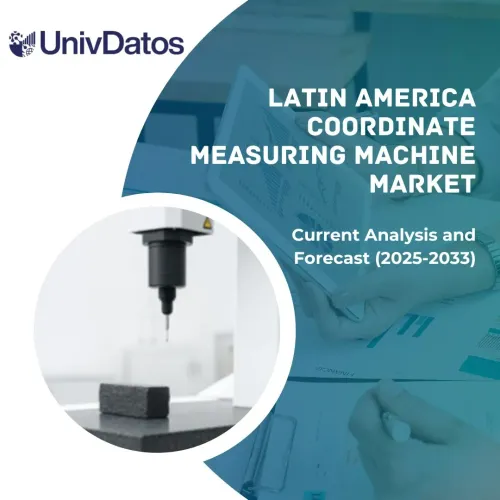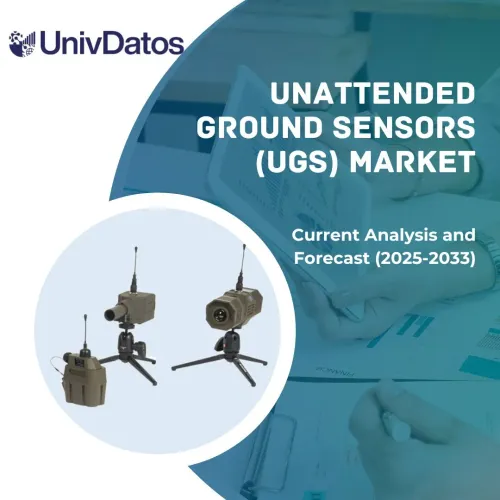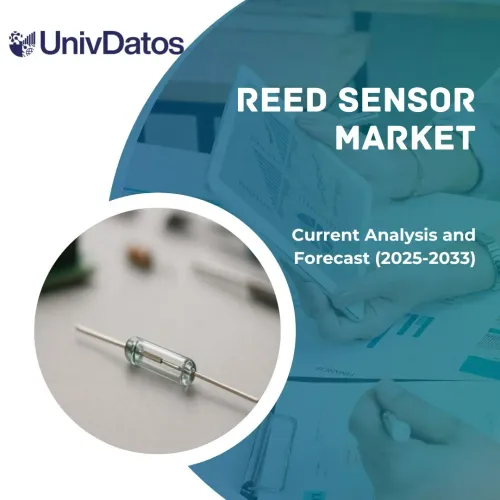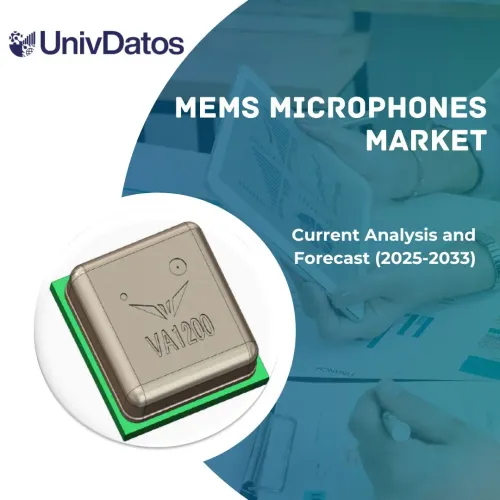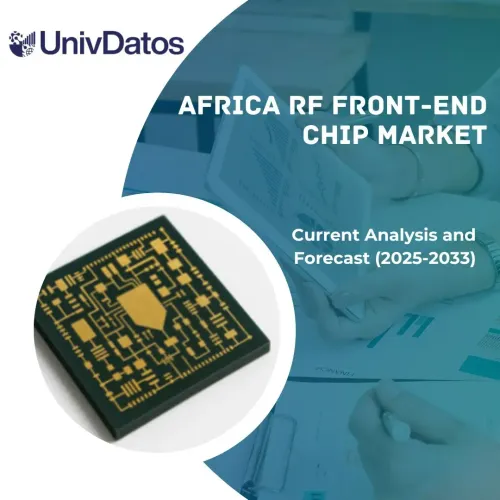- Inicio
- Acerca de nosotros
- Industria
- Servicios
- Leyendo
- Contáctenos
Mercado de cobre de alta conductividad libre de oxígeno: análisis actual y previsión (2024-2032)
Énfasis en el Tipo (Alambre, Tiras, Barra Colectora y Varillas, y Otros); Aplicación (Industrial, Automotriz, Electrónica y Eléctrica, Aeroespacial y Defensa, y Otros); Región/País.
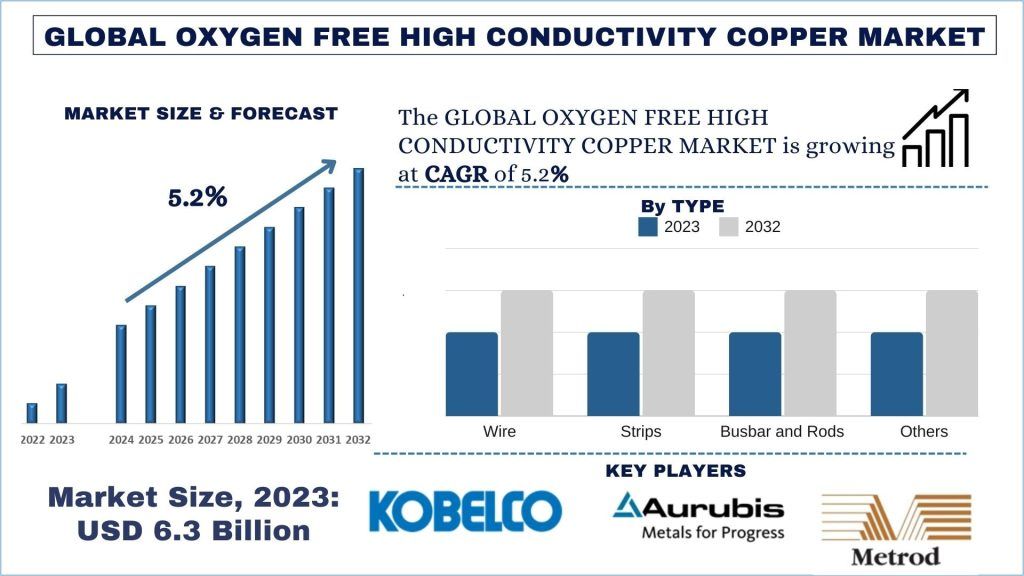 Tamaño y Pronóstico del Mercado de Cobre de Alta Conductividad Libre de Oxígeno
Tamaño y Pronóstico del Mercado de Cobre de Alta Conductividad Libre de Oxígeno
El mercado de Cobre de Alta Conductividad Libre de Oxígeno se valoró en USD 6.3 mil millones en 2023 y se espera que crezca a una fuerte CAGR de alrededor del 5.2% durante el período de pronóstico (2024-2032) debido al creciente uso de productos sostenibles.
Análisis del Mercado de Cobre de Alta Conductividad Libre de Oxígeno
El mercado de Cobre de Alta Conductividad Libre de Oxígeno (OFHC) está experimentando un crecimiento robusto, impulsado por la creciente demanda de cobre de alta calidad en industrias clave. El sector de la electrónica, en particular, es un importante impulsor, ya que el cobre OFHC es esencial para la producción de semiconductores, placas de circuito impreso (PCB) y otros componentes electrónicos. Además, la industria automotriz está adoptando el cobre OFHC para vehículos eléctricos (EV) y sistemas avanzados de asistencia al conductor (ADAS), lo que impulsa aún más el crecimiento del mercado.
Otro impulsor significativo es el sector de la energía renovable, donde el cobre OFHC es crucial para los paneles solares, las turbinas eólicas y los sistemas de almacenamiento de energía. El creciente enfoque en la sostenibilidad y la eficiencia energética está impulsando la demanda de cobre OFHC en estas aplicaciones. Además, los avances tecnológicos y las innovaciones en los procesos de fabricación están mejorando el rendimiento y la confiabilidad del cobre OFHC, lo que impulsa aún más el crecimiento del mercado.
El mercado de OFHC también está siendo testigo de importantes desarrollos en las tecnologías de reciclaje, que se están volviendo cada vez más importantes en el contexto de la sostenibilidad y la eficiencia de los recursos. El reciclaje de cobre no solo es beneficioso para el medio ambiente, sino también económicamente viable, ya que reduce la dependencia del mineral de cobre virgen y reduce los costos de producción. Como tal, existe un creciente énfasis en el desarrollo de procesos de reciclaje eficientes y rentables para el cobre OFHC, lo que se espera que impulse aún más el crecimiento del mercado. Además, la aparición de nuevas aplicaciones e industrias que requieren cobre de alta pureza, como la aeroespacial y los dispositivos médicos, presenta nuevas oportunidades de crecimiento en el mercado de OFHC. De cara al futuro, se espera que el mercado de OFHC continúe su trayectoria ascendente, impulsado por los continuos avances tecnológicos, la creciente adopción de vehículos eléctricos y la creciente demanda de soluciones de energía renovable. A medida que las industrias continúan priorizando la eficiencia y la sostenibilidad, se espera que la demanda de cobre OFHC de alta calidad se mantenga fuerte, posicionando al mercado para un crecimiento continuo en el futuro previsible.
Tendencias del Mercado de Cobre de Alta Conductividad Libre de Oxígeno
Esta sección analiza las tendencias clave del mercado que están influyendo en los diversos segmentos del mercado de Cobre de Alta Conductividad Libre de Oxígeno, según lo identificado por nuestro equipo de expertos en investigación.
Políticas Gubernamentales que Apoyan la Industria del Cobre de Alta Conductividad Libre de Oxígeno:
Las políticas e incentivos gubernamentales juegan un papel fundamental en la configuración del mercado de Cobre de Alta Conductividad Libre de Oxígeno (OFHC), influyendo significativamente en su trayectoria de crecimiento y dinámica del mercado. Las políticas que promueven la adopción de fuentes de energía renovables, como la energía solar y eólica, han sido fundamentales para impulsar la demanda de cobre OFHC en los sistemas de generación y transmisión de energía. Los incentivos destinados a acelerar la adopción de vehículos eléctricos (EV) también han contribuido al creciente uso de cobre OFHC en el cableado de EV y los sistemas de baterías. Además, las políticas de desarrollo de infraestructura, particularmente aquellas que se centran en ciudades inteligentes y redes de telecomunicaciones de alta velocidad, han creado una demanda sustancial de cobre OFHC en aplicaciones de transmisión de datos y eléctricas. Además, el apoyo gubernamental a las iniciativas de investigación y desarrollo (I+D), así como el establecimiento de estándares de la industria, ha desempeñado un papel fundamental en el fomento de la innovación y el crecimiento dentro del mercado de OFHC, asegurando su continua relevancia y competitividad en un panorama tecnológico en rápida evolución.
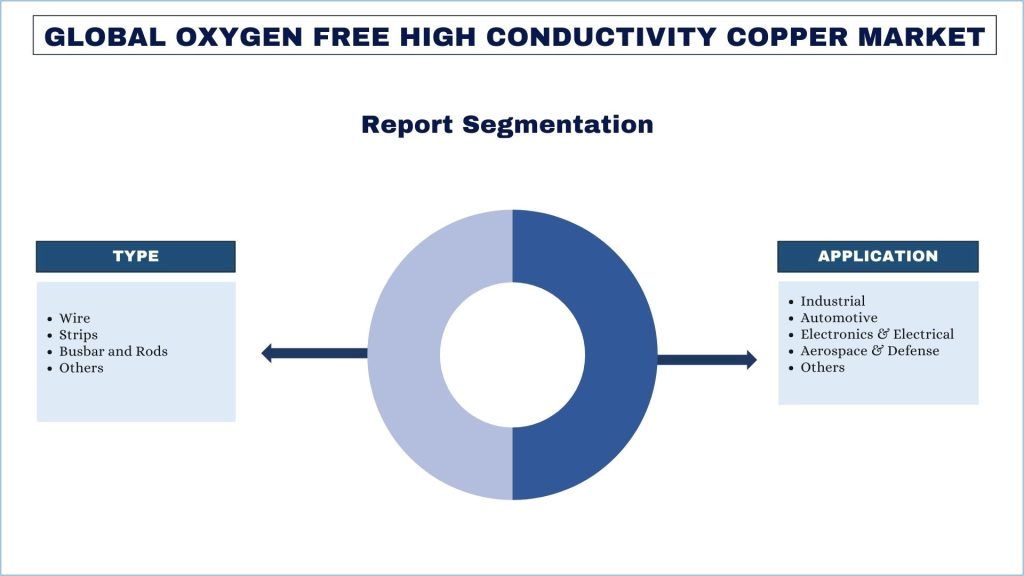
Se Espera que APAC Crezca con una CAGR Significativa Durante el Período de Pronóstico
La región de Asia-Pacífico (APAC) es un actor importante en el mercado de Cobre de Alta Conductividad Libre de Oxígeno (OFHC), impulsada por su rápida industrialización, urbanización y avances tecnológicos. Países como China, Japón, Corea del Sur e India son importantes contribuyentes a la demanda de cobre OFHC, particularmente en los sectores de electrónica, automotriz y energía renovable.
En China, el mayor consumidor de cobre a nivel mundial, el impulso del gobierno para el desarrollo de infraestructura y la adopción de vehículos eléctricos ha llevado a una demanda sustancial de cobre OFHC. Japón y Corea del Sur son líderes innovadores en las industrias electrónica y automotriz, impulsando la demanda de cobre de alta calidad para semiconductores, PCB y mazos de cables. India, con su creciente población y economía en crecimiento, presenta una importante oportunidad de mercado para el cobre OFHC en diversas aplicaciones.
El enfoque de la región APAC en la sostenibilidad y la eficiencia energética impulsa aún más la demanda de cobre OFHC en proyectos de energía renovable, como la energía solar y eólica. Además, la creciente urbanización de la región y el desarrollo de ciudades inteligentes requieren sistemas avanzados de transmisión de datos y eléctricos, lo que impulsa la necesidad de cobre de alta calidad.
En general, el crecimiento dinámico de la región APAC, junto con su creciente demanda de cobre de alta calidad en industrias clave, la convierte en un mercado fundamental para la industria OFHC, preparado para un crecimiento e innovación continuos.
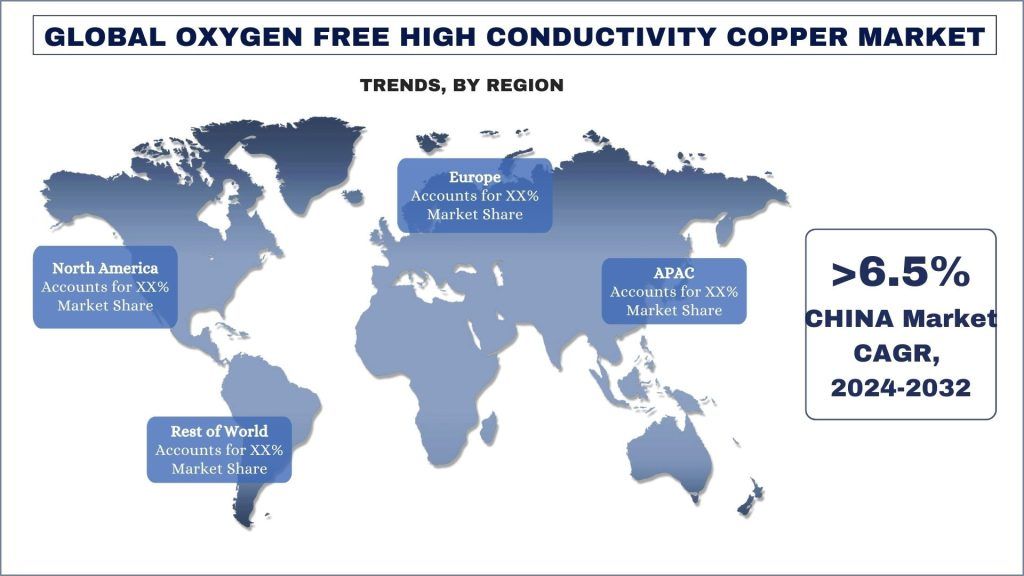
Descripción General de la Industria del Cobre de Alta Conductividad Libre de Oxígeno
El mercado de Cobre de Alta Conductividad Libre de Oxígeno es competitivo y fragmentado, con la presencia de varios actores del mercado globales e internacionales. Los actores clave están adoptando diferentes estrategias de crecimiento para mejorar su presencia en el mercado, como asociaciones, acuerdos, colaboraciones, lanzamientos de nuevos productos, expansiones geográficas y fusiones y adquisiciones. Algunos de los principales actores que operan en el mercado incluyen Kobe Steel, Mitsubishi Materials, Aurubis AG, Metrod Holdings Berhad, Watteredge-Unified Wire & Cable, Aviva Metals, Oriental Copper, California Fine Wire Co., Sarkuysan y Sam Dong.
Noticias del Mercado de Cobre de Alta Conductividad Libre de Oxígeno
- Junio de 2023 – Mitsubishi Materials Corporation Invierte en la Producción de Cobre OFHC: Mitsubishi Materials Corporation anunció una importante inversión para expandir su capacidad de producción de Cobre de Alta Conductividad Libre de Oxígeno (OFHC) para satisfacer la creciente demanda en las industrias electrónica y automotriz. La inversión incluye la instalación de nuevos equipos y el desarrollo de procesos de fabricación avanzados para mejorar la calidad y la eficiencia de la producción de cobre OFHC.
- Agosto de 2023 – Aurubis AG Introduce Nuevas Prácticas Sostenibles en la Producción de Cobre OFHC: Aurubis AG, un productor líder de cobre, reveló sus nuevas prácticas sostenibles en la producción de cobre OFHC, destinadas a reducir el impacto ambiental y promover los principios de la economía circular. Las iniciativas de la compañía incluyen el uso de fuentes de energía renovables, procesos de reciclaje mejorados y el desarrollo de soluciones de embalaje ecológicas para productos de cobre OFHC.
Cobertura del Informe del Mercado de Cobre de Alta Conductividad Libre de Oxígeno
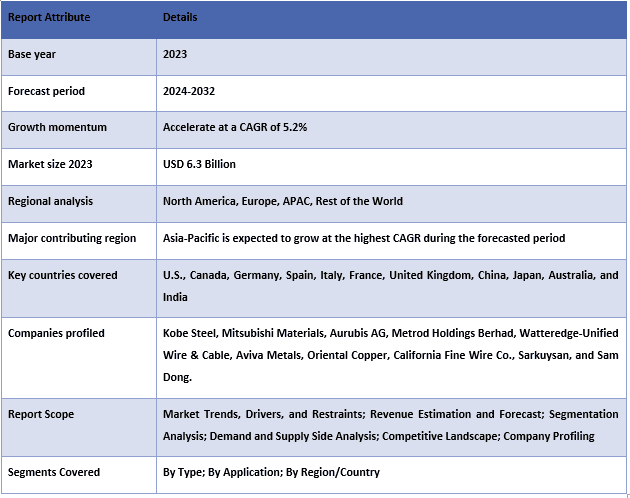
Razones para comprar este informe:
- El estudio incluye análisis de tamaño del mercado y pronósticos validados por expertos clave autenticados de la industria.
- El informe presenta una revisión rápida del rendimiento general de la industria de un vistazo.
- El informe cubre un análisis en profundidad de los pares prominentes de la industria con un enfoque principal en las finanzas comerciales clave, las carteras de productos, las estrategias de expansión y los desarrollos recientes.
- Examen detallado de los impulsores, restricciones, tendencias clave y oportunidades que prevalecen en la industria.
- El estudio cubre de manera integral el mercado en diferentes segmentos.
- Análisis profundo a nivel regional de la industria.
Opciones de Personalización:
El mercado global de Cobre de Alta Conductividad Libre de Oxígeno se puede personalizar aún más según los requisitos o cualquier otro segmento de mercado. Además de esto, UMI entiende que puede tener sus propias necesidades comerciales, por lo tanto, no dude en contactarnos para obtener un informe que se adapte completamente a sus requisitos.
Tabla de contenido
Metodología de Investigación para el Análisis del Mercado de Cobre de Alta Conductividad Libre de Oxígeno (2024-2032)
El análisis del mercado histórico, la estimación del mercado actual y la previsión del mercado futuro del Cobre de Alta Conductividad Libre de Oxígeno global fueron los tres pasos principales llevados a cabo para crear y explorar la adopción del Cobre de Alta Conductividad Libre de Oxígeno en las principales regiones a nivel mundial. Se llevó a cabo una exhaustiva investigación secundaria para recopilar las cifras históricas del mercado y estimar el tamaño actual del mercado. En segundo lugar, se tuvieron en cuenta numerosos hallazgos y supuestos para validar estas perspectivas. Además, también se realizaron exhaustivas entrevistas primarias con expertos de la industria en toda la cadena de valor del mercado global de Cobre de Alta Conductividad Libre de Oxígeno. Tras la suposición y validación de las cifras del mercado a través de entrevistas primarias, empleamos un enfoque de arriba hacia abajo/de abajo hacia arriba para pronosticar el tamaño completo del mercado. Posteriormente, se adoptaron métodos de desglose del mercado y de triangulación de datos para estimar y analizar el tamaño del mercado de los segmentos y subsegmentos de la industria. La metodología detallada se explica a continuación:
Análisis del Tamaño Histórico del Mercado
Paso 1: Estudio Profundo de Fuentes Secundarias:
Se realizó un estudio secundario detallado para obtener el tamaño histórico del mercado de Cobre de Alta Conductividad Libre de Oxígeno a través de fuentes internas de la empresa, como informes anuales y estados financieros, presentaciones de rendimiento, comunicados de prensa, etc., y fuentes externas que incluyen revistas, noticias y artículos, publicaciones gubernamentales, publicaciones de la competencia, informes del sector, bases de datos de terceros y otras publicaciones creíbles.
Paso 2: Segmentación del Mercado:
Después de obtener el tamaño histórico del mercado de Cobre de Alta Conductividad Libre de Oxígeno, realizamos un análisis secundario detallado para recopilar información histórica del mercado y compartirla para diferentes segmentos y subsegmentos para las principales regiones. Los principales segmentos se incluyen en el informe, como el tipo y la aplicación. Además, se realizaron análisis a nivel de país para evaluar la adopción general de los modelos de prueba en esa región.
Paso 3: Análisis de Factores:
Después de adquirir el tamaño histórico del mercado de diferentes segmentos y subsegmentos, realizamos un análisis de factores detallado para estimar el tamaño actual del mercado de Cobre de Alta Conductividad Libre de Oxígeno. Además, realizamos un análisis de factores utilizando variables dependientes e independientes, como el tipo y la aplicación del mercado de Cobre de Alta Conductividad Libre de Oxígeno. Se llevó a cabo un análisis exhaustivo de los escenarios de la demanda y la oferta teniendo en cuenta las principales asociaciones, fusiones y adquisiciones, la expansión empresarial y los lanzamientos de productos en el sector del Cobre de Alta Conductividad Libre de Oxígeno en todo el mundo.
Estimación y Previsión del Tamaño Actual del Mercado
Tamaño Actual del Mercado: Basándonos en la información práctica de los 3 pasos anteriores, llegamos al tamaño actual del mercado, los actores clave en el mercado global de Cobre de Alta Conductividad Libre de Oxígeno y las cuotas de mercado de los segmentos. Todos los porcentajes de cuotas divididas y los desgloses del mercado necesarios se determinaron utilizando el enfoque secundario mencionado anteriormente y se verificaron a través de entrevistas primarias.
Estimación y Previsión: Para la estimación y previsión del mercado, se asignaron ponderaciones a diferentes factores, incluidos los impulsores y las tendencias, las restricciones y las oportunidades disponibles para las partes interesadas. Después de analizar estos factores, se aplicaron técnicas de previsión relevantes, es decir, el enfoque de arriba hacia abajo/de abajo hacia arriba, para llegar a la previsión del mercado para 2032 para diferentes segmentos y subsegmentos en los principales mercados a nivel mundial. La metodología de investigación adoptada para estimar el tamaño del mercado abarca:
- El tamaño del mercado de la industria, en términos de ingresos (USD) y la tasa de adopción del Cobre de Alta Conductividad Libre de Oxígeno en los principales mercados a nivel nacional
- Todos los porcentajes de cuotas, divisiones y desgloses de los segmentos y subsegmentos del mercado
- Los actores clave en el mercado global de Cobre de Alta Conductividad Libre de Oxígeno en términos de productos ofrecidos. Además, las estrategias de crecimiento adoptadas por estos actores para competir en el mercado de rápido crecimiento
Validación del Tamaño y la Cuota de Mercado
Investigación Primaria: Se realizaron entrevistas en profundidad con los Líderes de Opinión Clave (KOLs), incluidos los Ejecutivos de Alto Nivel (CXO/VPs, Jefe de Ventas, Jefe de Marketing, Jefe de Operaciones, Jefe Regional, Jefe de País, etc.) en las principales regiones. Los hallazgos de la investigación primaria se resumieron y se realizó un análisis estadístico para probar la hipótesis establecida. Los datos de la investigación primaria se consolidaron con los hallazgos secundarios, convirtiendo así la información en perspectivas prácticas.
División de los Participantes Primarios en Diferentes Regiones
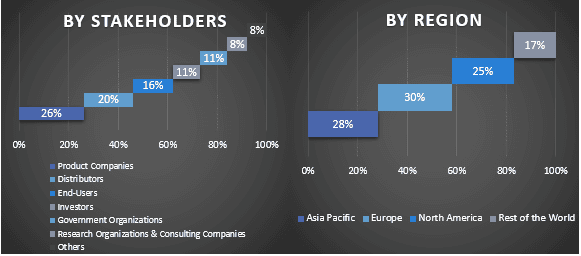
Ingeniería de Mercado
Se empleó la técnica de triangulación de datos para completar la estimación general del mercado y para llegar a cifras estadísticas precisas para cada segmento y subsegmento del mercado global de Cobre de Alta Conductividad Libre de Oxígeno. Los datos se dividieron en varios segmentos y subsegmentos después de estudiar varios parámetros y tendencias en las áreas de tipo y aplicación en el mercado global de Cobre de Alta Conductividad Libre de Oxígeno.
El principal objetivo del estudio del mercado global de Cobre de Alta Conductividad Libre de Oxígeno
Las tendencias actuales y futuras del mercado global de Cobre de Alta Conductividad Libre de Oxígeno se identificaron en el estudio. Los inversores pueden obtener información estratégica para basar su discreción para las inversiones en el análisis cualitativo y cuantitativo realizado en el estudio. Las tendencias actuales y futuras del mercado determinaron el atractivo general del mercado a nivel regional, proporcionando una plataforma para que el participante industrial explote el mercado sin explotar para beneficiarse de una ventaja de ser el primero en actuar. Otros objetivos cuantitativos de los estudios incluyen:
- Analizar el tamaño actual y previsto del mercado de la industria del Cobre de Alta Conductividad Libre de Oxígeno en términos de valor (USD). Además, analizar el tamaño actual y previsto del mercado de diferentes segmentos y subsegmentos
- Los segmentos en el estudio incluyen áreas de tipo y aplicación
- Definir y analizar el marco regulatorio para la industria del Cobre de Alta Conductividad Libre de Oxígeno
- Analizar la cadena de valor involucrada con la presencia de varios intermediarios, junto con el análisis de los comportamientos de los clientes y competidores de la industria
- Analizar el tamaño actual y previsto del mercado del mercado de Cobre de Alta Conductividad Libre de Oxígeno para la principal región
- Los principales países de las regiones estudiadas en el informe incluyen Asia Pacífico, Europa, América del Norte y el resto del mundo
- Perfiles de empresa del mercado de Cobre de Alta Conductividad Libre de Oxígeno y las estrategias de crecimiento adoptadas por los participantes del mercado para mantenerse en el mercado de rápido crecimiento
- Análisis regional profundo de la industria
Preguntas frecuentes Preguntas frecuentes
P1: ¿Cuál es el tamaño actual del mercado y el potencial de crecimiento del mercado de Cobre de Alta Conductividad Libre de Oxígeno?
P2: ¿Cuáles son los factores impulsores del crecimiento del mercado del cobre de alta conductividad libre de oxígeno?
P3: ¿Qué segmento tiene la mayor cuota en el mercado del Cobre de Alta Conductividad Libre de Oxígeno por Aplicación?
P4: ¿Cuáles son las tecnologías emergentes y las tendencias en el mercado del Cobre de Alta Conductividad Libre de Oxígeno?
P5: ¿Qué región dominará el mercado del cobre de alta conductividad libre de oxígeno?
Relacionados Informes
Los clientes que compraron este artículo también compraron


